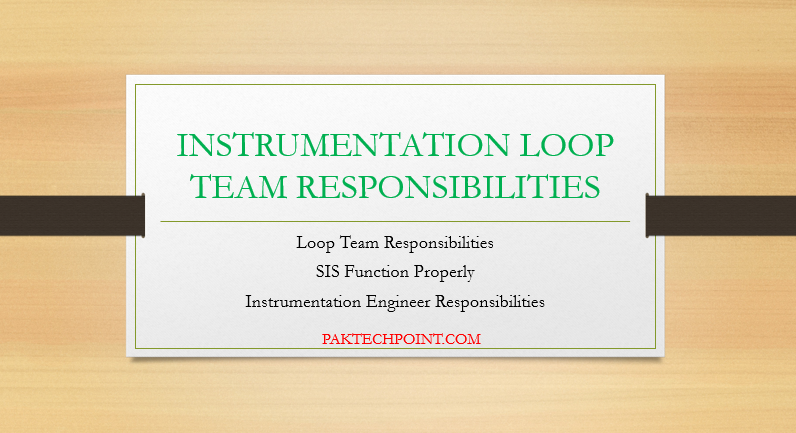Main keywords for this article are INSTRUMENTATION LOOP TEAM RESPONSIBILITIES, loop team responsibilities, SIS function properly, Instrumentation Engineer Responsibilities.

INSTRUMENTATION LOOP TEAM RESPONSIBILITIES
Control Room PIB (Process Interface Building) Inside Person
- Isolate power from field device from the input/output electronics for new installations and ensure that the loop power fuses are removed or disconnects in the CBJB or ICJB are open.
- Reconnect power for the field device as required.
- Verify the instrument tag number and the 1/0 point on the instrument schedule.
- Assist the outside person, as required, in locating the instrument in the field.
- Verify the instruments are terminated correctly (loop powered or field powered).
- Verify correct size and install instrument power fuse as required.
- Communicate the instrument range and fail safe position to the outside person in the field.
- Stroke Analog and Digital outputs for field verification by the outside person in the field.
- Verify the correct fail action and operation of AO’s & DO’s according to the DCS* control program, P&ID’s and documentation.
- Verify that the IPCS display/indication range, instrument range and documentation agree.
- Verify that redundant inputs display the same value (Applies to hardwired display only) Verify Digital Output & Digital Input convention for proper lamp action.
- Check graphics for proper light response in the correct place in DCS System.
- Zero calibrate the instrument to IPCS (DCS) graphics as required.
- Verify all differential pressure flow instruments are using square root linearization in the IPCS (DCS) or in the transmitter (but not both) (use an upscale input from the transmitter).
- Work with operations to verify Critical instruments and SIS function properly.
- Document daily activities, generate a punch list of instruments requiring work and distribute to the appropriate functions.
- Use the instrument schedule or loop checklist to document each loop as it is verified.
- Document problems and changes as they are completed.
- When the job is complete, deliver the completed documentation to the person in charge.
Outside Person Who is in Field
- Positively identify instruments in the field using the P&ID, IPCS graphics, or instrument location plan.
- Visually inspect instrument installation. Correct or record deficiencies (i. e., conduit covers, plugs, flow direction, etc.).
- Verify tag number and correct 1/0 number for the instrument.
- Connect communicator and monitor power up.
- Configure the instrument with the tag number and range information.
- Verify fail direction of the instrument.
- Perform zero/span trim to the IPCS graphics.
- For pressure sensing devices, function check by driving instrument mid scale by applying pressure (if possible) or with communicator or simulator.
- Verify valve position, operation, and fail safe condition.
- Verify motor I/O.
- Electrical responsible for verifying proper motor operation and proper rotation.
- Perform minor troubleshooting tasks in the field (10-15 minutes) and communicate all problems with inside person. If the problem cannot be resolved, this item will be put on the problem punch list.
- Mark the instrument with green tape when complete if everything is correct.
- Mark instruments with red tape that need to be worked on.
- Work with operations to verify (SIS) and SIS function properly.